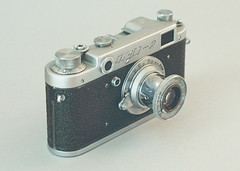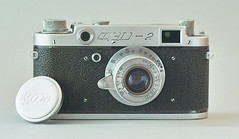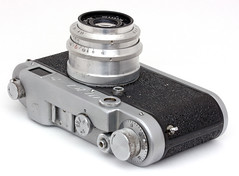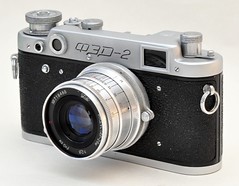Difference between revisions of "FED 2"
| Line 58: | Line 58: | ||
The FED 2 takes 39mm screw lenses. The [[rangefinder (device)|rangefinder]] is coupled to the lens via a cam at the top of the lens mount, shaped somewhat differently than the cam in a Leica, but capable of engaging any normal M39 lens. The rangefinder calibration can be somewhat delicate, so it is highly recommended that the lens be set to the minimum focal distance to avoid jarring the cam while mounting the lens. The field of view in the viewfinder is that of a 5cm/50mm lens. For other focal lengths, a separate turret or fixed viewfinder was placed on the accessory shoe. | The FED 2 takes 39mm screw lenses. The [[rangefinder (device)|rangefinder]] is coupled to the lens via a cam at the top of the lens mount, shaped somewhat differently than the cam in a Leica, but capable of engaging any normal M39 lens. The rangefinder calibration can be somewhat delicate, so it is highly recommended that the lens be set to the minimum focal distance to avoid jarring the cam while mounting the lens. The field of view in the viewfinder is that of a 5cm/50mm lens. For other focal lengths, a separate turret or fixed viewfinder was placed on the accessory shoe. | ||
| − | The cameras were factory-matched to a 50mm lens, for most of the production run the Industar 26m f:2.8 with a focal length usually slightly more than 50mm, depending on the year. These are sold with both focusing lever and a scalloped focusing ring, depending on the year. Early examples were equipped with the f:3.5 50mm | + | The cameras were factory-matched to a 50mm lens, for most of the production run the Industar 26m f:2.8 with a focal length usually slightly more than 50mm, depending on the year. These are sold with both focusing lever and a scalloped focusing ring, depending on the year. Early examples were equipped with the f:3.5 50mm Industar 22, a Tessar copy in a collapsible tube mount copied from the Leitz Elmar, itself a modified Tessar design with the diaphragm in a different position. Finally the L model was sold with the Industar 61, similar to the 26m but with lanthane glass and somewhat better build quality. The lenses are calibrated to the camera, and the manual indicates that other lenses should be calibrated before use as well, though it seems likely that this was rarely done in practice. These lenses are considered serviceable but are far from the quality of professional German lenses from the same time; Soviet optical design lagged behind the West in key ways. |
There is significant debate about whether Soviet lenses can be mounted on other M39 cameras and focus accurately, and vice versa for Soviet cameras and other lenses. A small majority of experts seem to believe that, while there may be errors, especially if the rangefinder has not been recently adjusted, these errors are negligible, especially at small aperture or with a distant subject. In fact, it seems that most examples of this camera will have little trouble mounting Leica, Canon and other fine M39 lenses, and may be one of the cheapest cameras capable of so doing. | There is significant debate about whether Soviet lenses can be mounted on other M39 cameras and focus accurately, and vice versa for Soviet cameras and other lenses. A small majority of experts seem to believe that, while there may be errors, especially if the rangefinder has not been recently adjusted, these errors are negligible, especially at small aperture or with a distant subject. In fact, it seems that most examples of this camera will have little trouble mounting Leica, Canon and other fine M39 lenses, and may be one of the cheapest cameras capable of so doing. | ||
| Line 64: | Line 64: | ||
=== Conclusion === | === Conclusion === | ||
| − | While hardly comparable to the early Leicas in terms of fit-and-finish, reliability and accuracy, there is something to be said for this camera: in some ways it does represent a upgrade from the early Leica II's: the convenience of a combined rangefinder/viewfinder cannot be understated, and a back-loading camera is a massive convenience compared to the bottom-loading Leica design. | + | While hardly comparable to the early Leicas in terms of fit-and-finish, reliability and accuracy, there is something to be said for this camera: in some ways it does represent a upgrade from the early Leica II's: the convenience of a combined rangefinder/viewfinder cannot be understated, and a back-loading camera is a massive convenience compared to the bottom-loading Leica design. The slow speeds of the Leica III were lacking, but the FED-3 would add these. |
Furthermore, the FED has never cost even in the vicinity of a Leica, and it is possible to buy functional examples online for the same amount one might pay for a K-mount Pentax SLR, or less. Millions were made, and on eBay at time of writing, the FED 2 is one of the most common Soviet cameras, matched only by some of the later FED models and perhaps the Zorki 4/4K. In fact, an economic route to professional image quality on film might be to purchase a FED, calibrate it well and find a used Leitz Elmar or other lauded 50mm (which will cost more than the camera did) and shoot with the resulting kit. Fast [[Canon]] M39 50mm's are sometimes available rather cheaply, for example. Even more economic is to mount a widely-available Soviet Jupiter-8 50mm F:2, a respected lens with good close-focus characteristics (although there is a certain risk of getting a dud due to uneven Soviet quality control.) Wide-angles from Soviet factories tend to run slightly higher, but long lenses are generally fairly economic. | Furthermore, the FED has never cost even in the vicinity of a Leica, and it is possible to buy functional examples online for the same amount one might pay for a K-mount Pentax SLR, or less. Millions were made, and on eBay at time of writing, the FED 2 is one of the most common Soviet cameras, matched only by some of the later FED models and perhaps the Zorki 4/4K. In fact, an economic route to professional image quality on film might be to purchase a FED, calibrate it well and find a used Leitz Elmar or other lauded 50mm (which will cost more than the camera did) and shoot with the resulting kit. Fast [[Canon]] M39 50mm's are sometimes available rather cheaply, for example. Even more economic is to mount a widely-available Soviet Jupiter-8 50mm F:2, a respected lens with good close-focus characteristics (although there is a certain risk of getting a dud due to uneven Soviet quality control.) Wide-angles from Soviet factories tend to run slightly higher, but long lenses are generally fairly economic. | ||
Revision as of 17:52, 24 June 2019
| FED 2 | ||
|---|---|---|
Manufacturer: FED Date of Production: 1955-1970 Type of Camera: Rangefinder Film Type: 35mm Lens: 39mm Screw Mount Shutter: Focal plane, cloth curtain Shutter range: 1/25-1/500th + Bulb Size (w*h*d): 140mm * 80mm * 32mm |
The FED 2 is a Leica-screw-mount rangefinder camera made at the FED factory in the Soviet Union. It is a new design that is quite different from the FED 1 in terms of its rangefinder/viewfinder setup: it has a longer rangefinder base (67mm, possibly the longest of any of the Russian Leica derivatives), a combined viewfinder and rangefinder window and an adjustable diopter for the viewing window. It also has a self-timer in later iterations, and a detachable back for film-loading, unlike the FED 1 and the Leicas it was copied from. The camera is still recognizable as a variation on the Barnack-designed screwmount Leicas, while its successors would not be.
Variations
There are six variations recognized by most collectors.
- FED 2a was introduced in 1955.
- FED 2b has flash sync added. The new shutter speed dial has the reference point on a center post that rotates with the dial as the shutter is fired.
- FED 2c has the flash sync port moved to the top deck from the body. It also has a mushroom-shaped film advance knob.
- FED 2d has a new set of shutter speeds, from 1/30 to 1/500, instead of the older set of 1/25 to 1/500.
- FED 2L is the only factory-designated model number; all other models are stamped FED 2 by the factory. The body is identical to the FED 2d body but the lens supplied is an Industar 61 with (radioactive) Lanthane glass instead of the Industar 26m used in models 2b to 2d.
- FED 2e is a FED 3b with the FED 2d shutter that does not have the slow speeds. Similar to the 3b, it does not have strap lugs but has a film advance lever. Production ended around 1970.
Operation
To load a film, two locks in the base of the camera need to be turned. The entire back and bottom can then be removed as a single unit, allowing easy access to the film chamber. Standard 35mm film cassettes are used, with film being wound onto a removable take-up spool (the latter often becomes difficult to remove on older cameras). Winding the film cocks the shutter and forwards the frame-counter simultaneously. The FED 2 has a manual frame-counter located below the wind-on knob, which must be reset by hand when loading film.
Shutter
The Fed 2 has an early-Leica-type cloth-curtain shutter with a single (fast) range: speeds from 1/25-1/500s (later 1/30-1/500 in the modern progression) and B. No FED 2 had 1/1000 or higher or a slow timer. After detaching the back, two screws on the underside of the camera allow you to adjust the spring tension and change the shutter speeds, which will have become slow over time if the camera has not been adjusted periodically. The shutter-speed dial rotates when the shutter is cocked and when it is released. To set it, after cocking the shutter, pull up on the dial and rotate it until the correct speed is indicated, then allow it to fall into place there.
As with almost all Russian focal-plane shutter cameras, whether Leica-based or Contax-based, it's important to cock the shutter before operating the shutter speed dial. Failing to do so may harm the mechanism by breaking a control pin which will be out of place and under undue pressure. If the pin does not break, it will still be in an improper place in the mechanism and this will cause the shutter to malfunction for many exposures afterwards. On the initial model, the shutter-speed is only displayed correctly when the camera is cocked, but on models after the 2b the indicator moves to compensate. It is also important not to turn the shutter dial between 1/500 and B, instead turning it the long way.
As on a Leica, the spring tension for each curtain roller may be adjusted by two screws on the inside of the bottom plate, restrained by two locking screws. This is not to be done lightly, but an amateur who has read the proper documentation can fix an uneven exposure by tensioning the curtain that is slow. This is done by rotating one of the screws very slightly.
Lens
The FED 2 takes 39mm screw lenses. The rangefinder is coupled to the lens via a cam at the top of the lens mount, shaped somewhat differently than the cam in a Leica, but capable of engaging any normal M39 lens. The rangefinder calibration can be somewhat delicate, so it is highly recommended that the lens be set to the minimum focal distance to avoid jarring the cam while mounting the lens. The field of view in the viewfinder is that of a 5cm/50mm lens. For other focal lengths, a separate turret or fixed viewfinder was placed on the accessory shoe.
The cameras were factory-matched to a 50mm lens, for most of the production run the Industar 26m f:2.8 with a focal length usually slightly more than 50mm, depending on the year. These are sold with both focusing lever and a scalloped focusing ring, depending on the year. Early examples were equipped with the f:3.5 50mm Industar 22, a Tessar copy in a collapsible tube mount copied from the Leitz Elmar, itself a modified Tessar design with the diaphragm in a different position. Finally the L model was sold with the Industar 61, similar to the 26m but with lanthane glass and somewhat better build quality. The lenses are calibrated to the camera, and the manual indicates that other lenses should be calibrated before use as well, though it seems likely that this was rarely done in practice. These lenses are considered serviceable but are far from the quality of professional German lenses from the same time; Soviet optical design lagged behind the West in key ways.
There is significant debate about whether Soviet lenses can be mounted on other M39 cameras and focus accurately, and vice versa for Soviet cameras and other lenses. A small majority of experts seem to believe that, while there may be errors, especially if the rangefinder has not been recently adjusted, these errors are negligible, especially at small aperture or with a distant subject. In fact, it seems that most examples of this camera will have little trouble mounting Leica, Canon and other fine M39 lenses, and may be one of the cheapest cameras capable of so doing.
Conclusion
While hardly comparable to the early Leicas in terms of fit-and-finish, reliability and accuracy, there is something to be said for this camera: in some ways it does represent a upgrade from the early Leica II's: the convenience of a combined rangefinder/viewfinder cannot be understated, and a back-loading camera is a massive convenience compared to the bottom-loading Leica design. The slow speeds of the Leica III were lacking, but the FED-3 would add these.
Furthermore, the FED has never cost even in the vicinity of a Leica, and it is possible to buy functional examples online for the same amount one might pay for a K-mount Pentax SLR, or less. Millions were made, and on eBay at time of writing, the FED 2 is one of the most common Soviet cameras, matched only by some of the later FED models and perhaps the Zorki 4/4K. In fact, an economic route to professional image quality on film might be to purchase a FED, calibrate it well and find a used Leitz Elmar or other lauded 50mm (which will cost more than the camera did) and shoot with the resulting kit. Fast Canon M39 50mm's are sometimes available rather cheaply, for example. Even more economic is to mount a widely-available Soviet Jupiter-8 50mm F:2, a respected lens with good close-focus characteristics (although there is a certain risk of getting a dud due to uneven Soviet quality control.) Wide-angles from Soviet factories tend to run slightly higher, but long lenses are generally fairly economic.
Extreme caution must be taken as there is much deception and the market is flooded with both enlarger lenses (which may have the same name as a rangefinder lens, but which do not have focusing mechanisms) and lenses for other 39mm mounts, which may have the wrong flange distance and will certainly lack a rangefinder coupling. For example, a Soviet half-frame viewfinder camera had a screw-in 28mm lens called the Industar-69 that is often sold as a compact wide-angle m39, despite having no coupling to the rangefinder cam. This lens has terrible performance on a full-frame body due to its small image circle. Also, while deception may not be involved, early Zenit cameras took 39mm screwmount lenses, many of which were special versions of Soviet m39 lenses, but these have a long flange distance and no coupling. The seller may confuse these with the m39 versions or the buyer may misunderstand. It is important to confirm that a lens is a rangefinder lens before buying. Contax/Kiev bayonet-mounting versions of almost all Soviet lenses exist, so caution should be taken to avoid these as well.
Images

|
| Fed 2b + FED 50mm collapsible lens image by Dries van den Elzen (Image rights) |

|
| Fed 2b + FED 50mm collapsible lens image by Dries van den Elzen (Image rights) |

|
| Fed 2b + Industar 50mm lens image by Martin Taylor (Image rights) |

|
| Red Fed 2c + 50mm Jupiter-8 lens image by Nicolas Vigier (Image rights) |
Links
- Fed 2 Models at USSRPhoto.com
- Matt's Cameras: FED 2
- FED-2 at From the infinity to the focal plane
- Lionel's FED 2 overview at 35mm-compact.com (in French)
- FED 2 service and cleaning (PDF), by Laika, at Pentax Manuals
- FED 2 English user manual (PDF), at Matt Denton Photography
- FED-2 Shutter Repair, at Stephen's Web Page
- Fed 2 at at Sylvain Halgand's www.collection-appareils.fr (in French)
